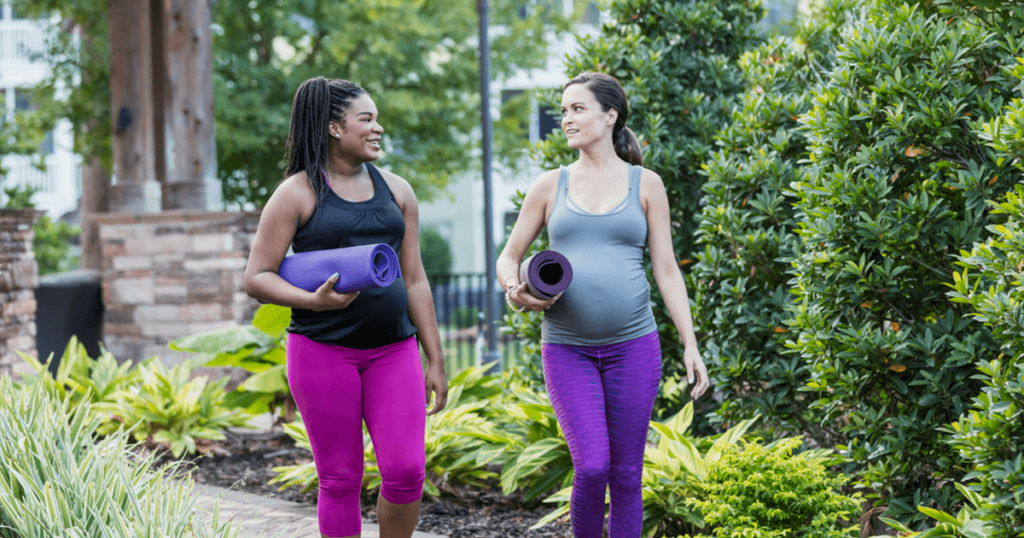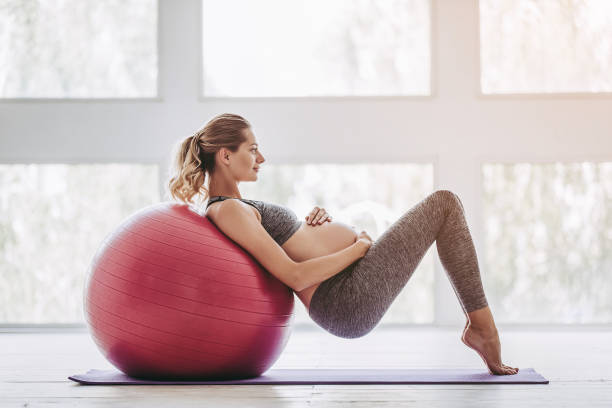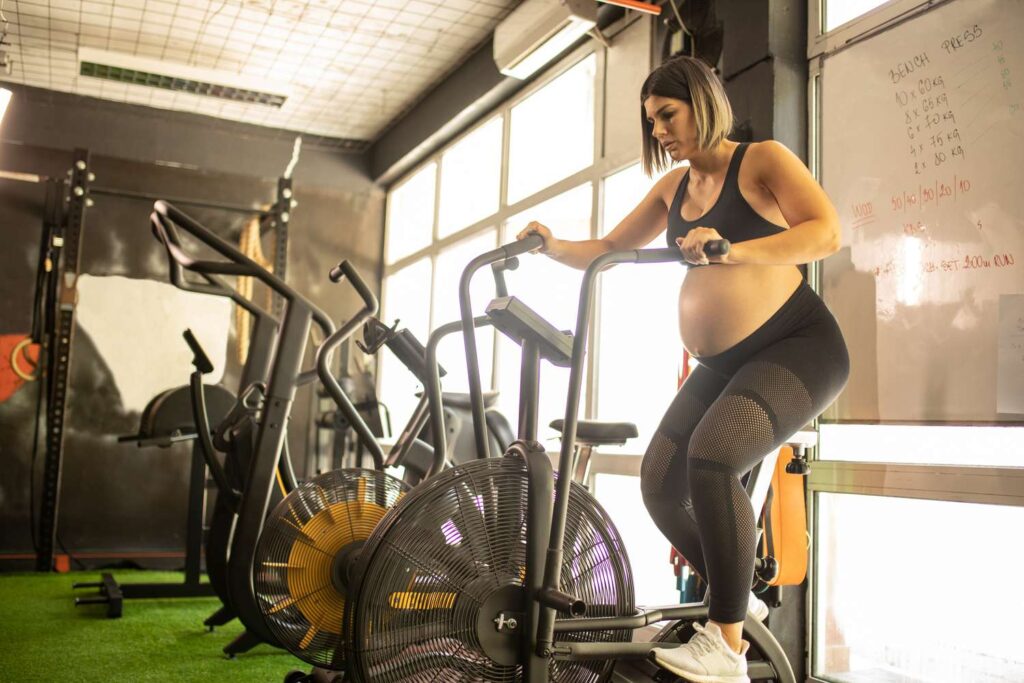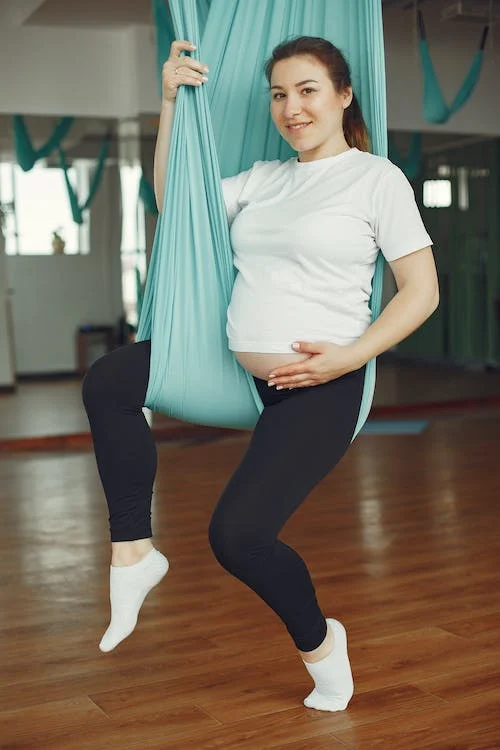Exercise during pregnancy can offer numerous benefits for both the expectant mother and her developing baby. Staying active can help maintain overall health, boost mood, alleviate common discomforts, promote better sleep, and even prepare the body for labor and postpartum recovery.
However, it’s essential to choose exercises that are safe and suitable for pregnancy. In this guide, we will explore ten exercises specifically designed for pregnant women. Remember to consult with your healthcare provider before starting any exercise routine and always listen to your body’s cues. Let’s dive into these exercises that can contribute to a healthier and more comfortable pregnancy journey.

Importance
Exercise is important for pregnant women due to the numerous benefits it offers for both the mother and the developing baby. Here are some key reasons why exercise is encouraged during pregnancy.
- Exercise during pregnancy helps maintain overall health and fitness.
- Regular physical activity can reduce the risk of pregnancy-related conditions like gestational diabetes and preeclampsia.
- Exercise boosts mood, reduces stress, and improves mental well-being.
- It helps manage weight gain within a healthy range and facilitates postpartum weight loss.
- Engaging in exercise can enhance energy levels and combat pregnancy-related fatigue.
- Regular physical activity promotes better sleep and reduces sleep disturbances.
- Exercise prepares the body for the physical demands of labor and childbirth.
- Prenatal yogacan alleviate common discomforts such as back pain, swelling, and constipation.
- Staying active during pregnancy contributes to a smoother postpartum recovery.
- Consult with a healthcare provider before starting or modifying an exercise routine during pregnancy for personalized guidance and safety.
Walking
A low-impact exercise that is safe for most pregnant women. It helps maintain cardiovascular fitness and can be done throughout pregnancy.

- Walking is a low-impact exercise suitable for pregnant women.
- It improves cardiovascular fitness.
- Walking helps manage weight gain during pregnancy.
- It releases endorphins, improving mood and reducing stress.
- Walking boosts energy levels.
- Regular walking promotes better sleep.
- It stimulates digestion, reducing constipation and bloating.
- Walking helps prepare the body for labor.
- It provides social and emotional benefits.
- Walking is accessible, convenient, and requires no special equipment.
Prenatal yoga
Focuses on gentle stretching, breathing techniques, and relaxation. It improves flexibility, promotes relaxation, and helps alleviate common pregnancy discomforts.

- Prenatal yoga is a safe and gentle exercise specifically designed for pregnant women.
- It improves flexibility, strength, and posture.
- Prenatal yoga helps reduce stress and promotes emotional well-being.
- It teaches breathing techniques and relaxation exercises for labor and delivery.
- Prenatal yoga strengthens the pelvic floor muscles, reducing the risk of urinary incontinence.
- The practice improves circulation and reduces swelling and varicose veins.
- Prenatal yoga fosters a sense of connection and bonding with the baby.
- Attending prenatal yoga classes provides a supportive community of fellow pregnant women.
- It promotes relaxation and better sleep during pregnancy.
- Prenatal yoga can contribute to a smoother postpartum recovery.
Swimming
Provides buoyancy and supports your growing belly, relieving pressure on your joints. Swimming and water aerobics are low-impact exercises that work the whole body.

- Swimming is a wonderful exercise for pregnant women due to its numerous benefits.
- The buoyancy of water provides a low-impact and supportive environment for the body.
- It reduces strain on joints and ligaments, making it gentle on the body during pregnancy.
- Swimming engages the entire body, providing a comprehensive workout.
- It strengthens the cardiovascular system, tones muscles, and improves endurance.
- Swimming can alleviate swelling in the legs and feet, which are common discomforts during pregnancy.
- It supports the weight of the growing belly, reducing pressure on the spine and alleviating back pain.
- Swimming promotes circulation, enhancing blood flow and oxygen delivery to both the mother and baby.
- It helps regulate body temperature, providing a refreshing and cooling activity during pregnancy.
- Being in the water has a calming effect, offering relaxation and stress relief.
- Regular swimming can contribute to better sleep patterns and improved sleep quality.
- Consult with your healthcare provider before swimming to ensure it’s safe for you and your baby.
Prenatal Pilates
A modified version of Pilates that emphasizes core strength, flexibility, and posture. It can help with back pain and pelvic stability during pregnancy.

- Prenatal Pilates is a highly beneficial exercise option for pregnant women, offering a range of advantages.
- It focuses on strengthening the core muscles, including the abdominals, back, and pelvic floor.
- Prenatal Pilates improves stability and support for the growing belly, alleviating back pain.
- The exercises emphasize proper posture and alignment, reducing discomfort associated with poor alignment.
- Prenatal Pilates incorporates stretching exercises to improve flexibility and range of motion.
- It promotes body awareness, helping pregnant women connect with their changing bodies.
- Prenatal Pilates includes specific exercises to strengthen the pelvic floor muscles, preventing issues like urinary incontinence.
- It improves balance and stability through controlled movements and strengthening supporting muscles.
- Prenatal Pilates prepares the body for labor and delivery by targeting relevant muscles.
- It incorporates breathing techniques and mindful movement for stress relief and relaxation.
- Prenatal Pilates aids in postpartum recovery, regaining abdominal strength and support.
- The exercises help maintain muscle tone and manage weight gain during pregnancy.
- Engaging in Prenatal Pilates boosts body confidence and empowers women during pregnancy.
Remember to consult with your healthcare provider before starting Prenatal Pilates or any exercise program during pregnancy to ensure it is safe for you and your baby.
Prenatal strength training
Light to moderate strength training using appropriate weights or resistance bands can help maintain muscle tone and prepare your body for the physical demands of pregnancy and childbirth.

- Prenatal strength training during pregnancy offers numerous benefits.
- It increases strength and endurance.
- Strength training improves posture and stability, alleviating discomfort.
- It enhances overall fitness and cardiovascular health.
- Strength training helps manage weight gain during pregnancy.
- It promotes better bone health and increases bone density.
- Strengthening exercises prepare the body for labor and delivery.
- Prenatal strength training aids in postpartum recovery.
- Consult with your healthcare provider before starting a strength training program.
- Focus on proper form and technique to ensure safety.
- Modify exercises as pregnancy progresses to accommodate the changing body.
- Stay hydrated and take regular breaks during workouts.
- Listen to your body and avoid pushing beyond your limits.
- If experiencing pain or discomfort, consult with your healthcare provider.
- Prenatal strength training can be a safe and effective way to maintain fitness during pregnancy.
Prenatal strength training can be a safe and effective way to maintain fitness and support a healthy pregnancy. However, it’s essential to consult with your healthcare provider for personalized advice and guidance throughout your pregnancy journey.
Stationary biking
A low-impact cardiovascular exercise that helps strengthen leg muscles without putting stress on your joints.

- Stationary biking during pregnancy offers a range of benefits.
- It provides a low-impact cardiovascular exercise option.
- Stationary biking is joint-friendly and reduces the risk of falls or injuries.
- The intensity of the workout can be adjusted based on fitness level and comfort.
- It helps regulate body temperature during indoor workouts.
- Cycling can reduce swelling in the legs and ankles.
- Stationary biking engages the leg muscles and provides gentle core strengthening.
- It is a low-impact exercise that puts minimal strain on the pelvic floor.
- Stationary biking offers comfort and convenience for home or gym workouts.
- Consult with your healthcare provider before starting or continuing a stationary biking routine.
- Listen to your body, stay hydrated, and stop exercising if you experience pain or discomfort.
- Gradually increase the duration and intensity of workouts as tolerated.
- Seek medical advice if you have specific concerns or medical conditions during pregnancy.
Remember to listen to your body, stay properly hydrated, and stop exercising if you experience any pain, discomfort, or unusual symptoms. Gradually increase the duration and intensity of your workouts as tolerated and consult with your healthcare provider if you have any questions or concerns during your pregnancy journey.
Prenatal aerobics
Joining a prenatal aerobics class specifically designed for pregnant women can provide a safe and enjoyable workout that combines cardio and strength exercises.

- Prenatal aerobics during pregnancy offers several benefits.
- It promotes cardiovascular fitness and improves endurance.
- Prenatal aerobics typically focuses on low-impact exercises to minimize joint stress.
- It provides a full-body workout, strengthening and toning muscles.
- Regular participation in prenatal aerobics can help manage weight gain.
- Aerobic exercise releases endorphins, enhancing mood and reducing stress.
- It improves circulation, benefiting the overall health of both mother and baby.
- Prenatal aerobics can help prepare the body for labor and delivery.
- Participating in classes or group exercises provides social interaction and support.
- Consult with your healthcare provider before starting any prenatal aerobics program.
- Listen to your body, modify exercises as needed, and avoid overexertion.
- Choose a prenatal aerobics program led by a qualified instructor.
- They can provide appropriate modifications and ensure safety during pregnancy.
Remember to choose a prenatal aerobics program or class that is specifically designed for pregnant women and led by a qualified instructor. They can provide appropriate modifications and ensure the exercises are safe and suitable for your stage of pregnancy.
Kegel exercises
These exercises strengthen the pelvic floor muscles, which can help with urinary incontinence during pregnancy and aid in postpartum recovery.

- Kegel exercises during pregnancy can strengthen the pelvic floor muscles.
- Strong pelvic floor muscles can help prevent urinary incontinence and pelvic organ prolapse.
- Kegels prepare the muscles for labor and can aid in the pushing phase.
- They contribute to postpartum recovery by restoring muscle tone.
- Improved blood circulation to the pelvic area is a benefit of Kegel exercises.
- Strong pelvic floor muscles can enhance sexual satisfaction.
- Kegels are easy to perform discreetly, anytime, and anywhere.
- Seek guidance from a healthcare provider for proper technique.
- Customize the intensity and frequency of Kegel exercises.
- Consistency is important for optimal results.
- Ensure the exercises are safe for your individual pregnancy.
- Listen to your body and consult with a healthcare provider if you experience any discomfort or pain.
Remember to listen to your body and avoid overexertion when performing Kegel exercises. If you experience any pain or discomfort, consult with your healthcare provider for further guidance and evaluation.
Modified squats
Stand with your feet shoulder-width apart, and slowly lower your body into a squat position while keeping your back straight. Squats help strengthen the lower body muscles and prepare for labor

- Modified squats during pregnancy strengthen the lower body.
- They engage the pelvic floor muscles while maintaining proper form.
- Improved balance and stability are benefits of modified squats.
- They prepare the body for labor and delivery by engaging the relevant muscles.
- Modified squats increase flexibility in the hips, lower back, and thighs.
- Core muscles are activated during squats, promoting stability and reducing back pain.
- Adjustments can be made for comfort and to accommodate the changing body.
- Prioritize safety and listen to your body during modified squats.
- Consult with your healthcare provider before starting or continuing the exercise.
- Warm up before performing squats and maintain proper hydration.
- Start with lighter weights or no weights and gradually increase intensity.
- Seek guidance if you have concerns or questions about modified squats during pregnancy.
Remember to warm up before performing modified squats, stay properly hydrated, and use proper form and technique. Start with lighter weights or no weights at all, and gradually increase the intensity and duration of the exercise as tolerated. If you have any concerns or questions, consult with your healthcare provider for further guidance.
Pelvic tilts
On your hands and knees, gently tilt your pelvis backward, arching your back, and then tilt your pelvis forward, rounding your back. Pelvic tilts help strengthen the core muscles and alleviate back pain.

- Pelvic tilts during pregnancy strengthen the core muscles.
- They can provide relief from lower back pain.
- Pelvic tilts help maintain proper pelvic alignment.
- They prepare the body for labor and familiarize it with natural movements.
- Improved posture is a benefit of pelvic tilts.
- They promote relaxation and release tension in the lower back and pelvic area.
- Pelvic tilts are a simple and versatile exercise.
- Deep breathing can be incorporated for added relaxation.
- Consult with your healthcare provider before starting pelvic tilts.
- Listen to your body and adjust the range of motion as needed.
- Start with a small range of motion and gradually increase.
- Perform pelvic tilts regularly for consistent benefits.
Remember to incorporate pelvic tilts into your routine gradually, starting with a small range of motion and gradually increasing as you become more comfortable. Consistency is key, so aim to perform pelvic tilts regularly to reap the benefits throughout your pregnancy.
Engaging in regular exercise during pregnancy can be immensely beneficial for both the mother and the growing baby. Exercise promotes physical strength, cardiovascular health, and flexibility, while also boosting mood and reducing stress. It can help manage weight gain, alleviate common discomforts, and prepare the body for labor and delivery. However, it is crucial to consult with a healthcare provider before starting any exercise program during pregnancy, as individual circumstances and medical considerations may vary. Remember to listen to your body, stay hydrated, and choose exercises that are safe and comfortable. With proper guidance and a mindful approach, exercise can be an empowering and enjoyable part of the journey towards a healthy pregnancy and postpartum recovery.


